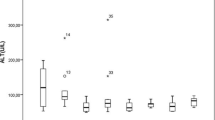Abstract
Carbon tetrachloride (CCl4) caused a dose-dependent increase in urinary taurine which correlated with both the histological and biochemical assessment of liver damage. The peak elevation in urinary taurine occurred within the first 48 h after dosing but there was still significant taurinuria 72 and 96 h after the intermediate dose (1 ml.kg−1) and highest dose (2 ml.kg−1), respectively. Levels of taurine in serum were also elevated over the 24 h period following a hepatotoxic dose (2 ml.kg−1) of CCl4. In contrast, although initially elevated, levels of taurine in the liver declined over the 24 h period following dosing and were significantly lower 96 h after a hepatotoxic dose of CCl4 (2 ml.kg−1). Male rats showed a different urinary profile for taurine than female rats after dosing with CCl4. A reduction in food intake seemed to lower urinary taurine levels although these changes were not statistically significant. There was a significant correlation between the level of urinary taurine and the level of serum AST for individual animals given a hepatotoxic dose of CCl4 (2 ml.kg−1). The data presented suggest that: i) taurine is produced by the liver in response to a toxic insult and subsequent leakage from damaged cells leads to increased levels in the urine; ii) the urinary taurine level may be a useful non-invasive marker of liver damage.
Similar content being viewed by others
References
Angel CR, Noonan TR (1959) Urinary taurine excretion patterns in the rat, rabbit, guinea pig and dog following exposure to whole body X-radiation. Fed Proc 19: 353
Anzano MA, Naewbanij J, Lamb AJ (1978) Simplified two-step columnchromatographic determination of taurine in urine. Clin Chem 24: 321–325
Bowden DH, Goyer RA (1962) Drug-induced muscle necrosis with massive taurinuria. Arch Pathol 74: 59–63
Chesney RW (1985) Taurine: its biological role and clinical implications. Adv Pediatr 32: 1–42
Chesney RW, Jax DK, Scriver CR, Mohyuddin F (1978) Taurine transport in mammalian kidney. In: Barbeau A, Huxtable RJ (eds) Taurine and neurological disorders. Raven Press, New York, pp 73–93
Cornish HH, Ryan RC (1964) A study of carbon tetrachloride. VI Aminoaciduria in response to carbon tetrachloride inhalation. Toxicol App Pharmacol 6: 96–102
Datta SC, Naryanaswami A (1983) Fluorimetric estimation of taurine in tissue extracts and biological fluids. Ital J Biochem 32: 297–305
Dent CE, Walshe JM (1954) Amino acid metabolism. Br Med Bull 10: 247–250
Durkin TA, Anderson GM, Cohen DJ (1988) High-performance liquid chromatographic analysis of neurotransmitter amino acids in the brain. J Chromatogr 428: 9–15
Gartland KPR, Bonner FW, Nicholson JK (1988) Investigations into the biochemical effects of region-specific nephrotoxins. Mol Pharmacol 35: 242–250
Garvin JE (1960) A new method for the determination of taurine in tissues. Arch Biochem Biophys 91: 219–225
Goyer RA, Yin MW, Bowden DH (1964) Taurine excretion and muscle necrosis. Proc Soc Exp Biol Med 116: 534–536
Hayes KC, Sturman JA (1981) Taurine in metabolism. Annu Rev Nutr 1: 401–425
Hirai T, Ohyama H, Kido R (1987) A direct determination of taurine in perchloric acid-deproteinized biological samples. Anal Biochem 163: 339–342
Huxtable R, Bressler R (1972) Taurine and isethionic acid: distribution and interconversion in the rat. J Nutr 102: 805–814
Jacobsen JG, Smith Jr LH (1968) Biochemistry and physiology of taurine and taurine derivatives. Physiol Rev 48 [2]: 424–511
Kay RE, Early JC, Entenman C (1957) Increased urinary excretion of taurine and urea by rats after X-irradiation. Radiat Res 6: 98–109
Larsen BR, Grosso DS, Chang SY (1980) A rapid method for taurine quantitation using high performance chromatography. J Chromatogr Sci 18: 233–236
Mikasa H, Ageta T, Mizoguchi N, Kodama H (1980) Simple assay method using isotachophoresis for taurine in tissues of the rat. J Chromatogr 202: 504–506
Naftalin L, Sexton M, Whitaker JF, Tracy D (1969) A routine procedure for estimating serum gamma-glutamyl transpeptidase activity. Clin Chim Acta 26: 293
Nakashima T, Takino T, Kuriyama K (1983) Therapeutic and prophylactic effects of taurine administration on experimental liver injury. In: Kuriyama K, Huxtable RJ, Iwata H (eds) Sulfur amino acids: biochemical and clinical aspects. Alan R. Liss, Inc., New York, pp 449–459
Sanins SM, Nicholson JK, Elcombe C, Timbrell JA (1990) Hepatotoxininduced hypertaurinuria: a proton NMR study. Arch Toxicol 64: 407–411
Sorbo B (1961) A method for the determination of taurine in urine. Clin Chem Acta 6: 87–90
Thomas EL, Grisham MB, Melton DF, Jefferson MM (1985) Evidence for a role of taurine in the in vitro oxidative toxicity of neutrophils toward erythrocytes. J Biol Chem 260: 3321–3329
Waterfield CJ, Turton JA, Scales MDC, Timbrell JA (1990a) Taurine synthesis in isolated rat hepatocytes in suspension exposed to carbon tetrachloride. Biochem Soc Trans 18: 1218–1219
Waterfield CJ, Turton JA, Scales MDC, Timbrell JA (1990b) Changes in urinary and hepatic taurine levels in rats treated with hepatotoxins. Proceedings of Eurotox 90, Leipzig, Sept. 1990, Abstr. 56
Worden JA, Stipanuk MH (1985) A comparison by species, age and sex of cysteinesulfinate decarboxylase activity and taurine concentrations in liver and brain of animals. Comp Biochem Physiol 82B: 233–239
Wright CE, Tallan HH, Yong YL (1986) Taurine: biological update. Annu Rev Biochem 55: 427–453
Yoshida M, Hara I (1985) Variation of cysteine level by chlorobenzene-induced pertubation of glutathione metabolism in rat liver. J Nutr Sci Vitaminol 31: 69–76
Zelikovic I, Chesney RW (1989) Taurine. In: New protective roles for selected nutrients. Alan R Liss, Inc. New York, pp 253–294
Zimmerman HJ (1978) Hepatotoxicity: the adverse effects of drugs and other chemicals on the liver. Appleton-Century-Crofts, New York
Author information
Authors and Affiliations
Rights and permissions
About this article
Cite this article
Waterfield, C.J., Turton, J.A., Scales, M.D.C. et al. Taurine, a possible urinary marker of liver damage: a study of taurine excretion in carbon tetrachloride-treated rats. Arch Toxicol 65, 548–555 (1991). https://doi.org/10.1007/BF01973715
Received:
Revised:
Accepted:
Issue Date:
DOI: https://doi.org/10.1007/BF01973715




